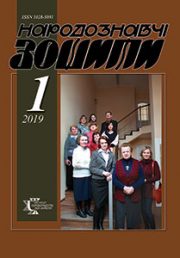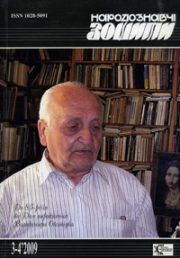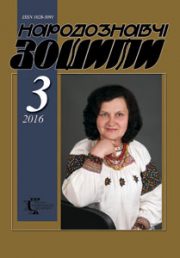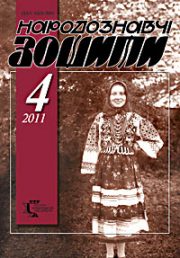The Ethnology Notebooks. 2021. № 3 (159), 615—620
UDK 392.1:392.5:393.05
DOI https://doi.org/10.15407/nz2021.03.615
STRUCTURES OF CYCLES OF FAMILY RITES THROUGH THE PRISM OF THE FERTILITY PHENOMENON
KUKHARENKO Oleksandr
- ORCID ID: https://orcid.org/0000-0001-5421-1004
- Candidate of Philological Sciences, Associate Professor,
- Kharkiv State Academy of Culture,
- 4, Bursatsky Descent, 61000, Kharkiv, Ukraine,
- Contacts: e-mail: art-red@ukr.net
Abstract. The coherence of the structures of family rites created by the researcher with the existing scientific concepts of the division of ritual time and space into periods of production, use and destruction of ritual attributes opens wide prospects for further research. The functions of such attributes at different stages of maternity rites were performed by the bed of a pregnant woman and a newborn, secundines and umbilical cord, festive table dishes and pot-luck. The most important attribute of funeral rites is the eternity box with the dead, wedding — the chasteness of the bride.
Thanks to the specified researches there is an improvement of structures of family rites, verification of quantity of episodes, correctness of their formulation. It is noticed that the production, use and destruction of ritual attributes in the structure resonate with the definition of the nature of each episode. Therefore, by means of comparison and verification it is possible to reconcile both directions, especially since one of the natures of action is the creation of a ritual attribute.
The study also revealed an important antinomy: fertility — death. Thus, development of opposition of two antinomic components occurs simultaneously with development of a plot and growth of level of sacralization from one rite to another.
The purpose of the article is to compare the structures of two cycles of family rites — maternity and funeral — within the framework of structural and functional analysis.
Sacralization of profane reality during the performance of ritual actions is carried out by saturating them with elements of fertility. As a result of studying the structures of three cycles — wedding, funeral and maternity — it was possible to conclude that sacralization, at least in these rites, is always a sacralization of fertility. Because it is fertility that provokes and provides for insemination, gives birth to life, guarantees a bountiful harvest and survival of the human community, frees from the deadly effects of the afterlife, as well as encourages faith in help of the dead as a necessary condition for existence of an ancestral cult, possibility of the influence on land fertility, fecundity of livestock, human regeneration.
The article uses culturological, comparative, systemic, statistical research methods.
Keywords: Ukrainian ritualism, family rites, structural and functional method, sacralization, fertility.
Received 30.05.2021
REFERENCES
- Tailor, E.B. (1989). Primitive culture. Moscow [in Russian].
- Halkovskii, N.M. (1913). The struggle of Christianity with the remnants of paganism in Ancient Russia (Vol. 2).Moscow [in Russian].
- Frezer, D.D. (1986). The Golden Bough: The Study of Magic and Religion. Moscow [in Russian].
- Boriak, O.O. (2009). Baba-midwife in the cultural and historical tradition of Ukrainians: between profane and sacred: a monograph. Kyiv [in Ukrainian].
- Ihnatenko, I.V. (2013). The female body in the traditional culture of Ukrainians. Kyiv [in Ukrainian].
- Kabakova, H.I. (2001). Anthropology of the female body in the Slavic tradition. Moscow [in Russian].
- Maierchyk, M.S. (2011). Ritual and body. Structural and semantic analysis of Ukrainian rites of the family cycle. Kyiv [in Ukrainian].
- Eliade, M. (1994). Sacred and secular. Moscow [in Russian].
- Ivanova, R. (1984). Bulgarian folk wedding. Sofia[in Bulgarian].
- Tolstoi, N.I. (Ed.). (1995). Slavic antiquities: Ethnolinguistic dictionary: in 5 vol. (Vol. 2). Moscow [in Russian].
- Kukharenko, O.O., & Kukharenko, A.V. (2019). Aims of ritual ceremonies and determining the nature of the actions of episodes in the structure of the cycle of national wedding ceremonies. Notes on Art Criticism (Issue 35, pp. 22—27) [in Ukrainian].
- Kukharenko, O. (2018). Structure and Functions of the Maternity Cycle of Rites in the Traditional National Ritualism. Paradigm of Knowledge. Multidisciplinary Scientific Journal, 4, 73—85.
- Kukharenko, O. (2018). Funeral Ceremony in the System of Structural-Functional Studies of Family Objectives. Paradigm of Knowledge. Multidisciplinary Scientific Journal, 2, 132—144.
- Chubynskyj, P.P. (Ed.). (1877). Proceedings of an ethnographic and statistical expedition to the West Russian Territory (Vol. 4) [in Russian].







